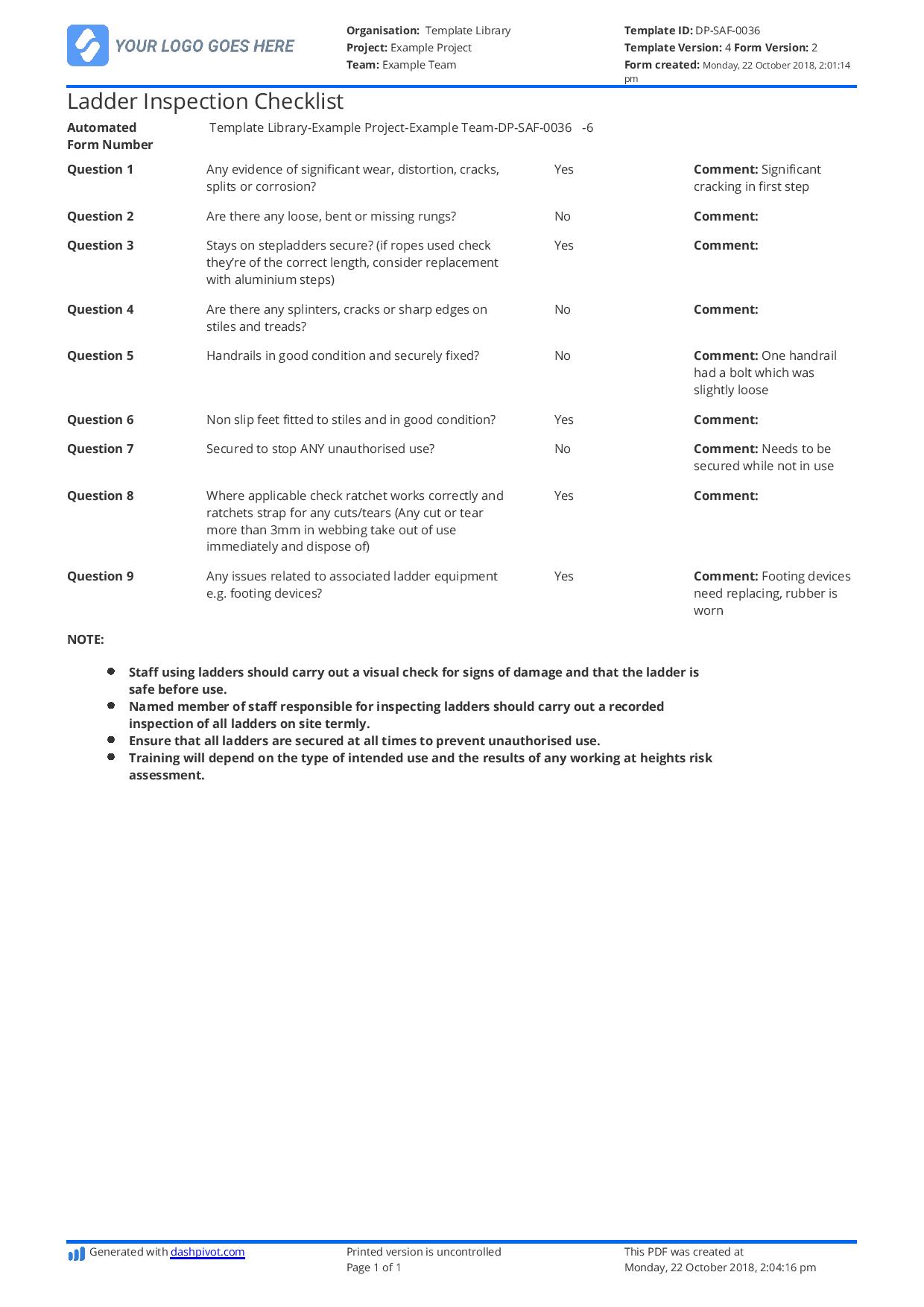Dashpivot Article – OSHA Ladder Safety
OSHA Ladder Safety
Get to know about OSHA's ladder safety standards, how to enforce practical steps when working at heights, and explore easier ways to stay compliant with these regulations.

Table of Contents
Article Summary
- A ladder inspection checklist that encompasses the ladder safety regulations can help establishments easily comply with OSHA’s ladder safety requirements all the while maintaining a safe working environment.
- OSHA has provided regulations on ladder safety that employers must comply with to prevent any unwanted accidents, injuries, or casualties when making use of a ladder.
- OSHA’s regulatory provisions and ladder safety requirements involve the following: design regulations, allowable load capacity, ladder maintenance and inspection, safe working practices, and training.
Why is OSHA Ladder Safety Compliance Important?
Ladders may look like basic tools that help us get hold of areas that are out of our reach. However, what many take for granted has caused several unwanted injuries while using this handy equipment.
According to the United States Bureau of Labor Statistics, in the year 2020, there was a total of 22,710 occupational ladder injuries, with 85% of these resulting from falls. From these falls, 22% have been tabulated to have caused serious injuries, and 14% of these serious injuries caused patients to stay a long period of time in the hospital.
To prevent such unwanted accidents and casualties, it is imperative that companies comply with standards and regulations set by OSHA. OSHA's standards provide clear guidelines on the use of ladders so that any potential hazards that may arise during their use are eliminated. To enhance the implementation of these regulations, it would be beneficial for establishments to inspect ladders. Ladder inspections can help find hazards that could potentially endanger workers.
How to format your Ladder Inspections to stay OSHA compliant
There are several approaches to maintaining compliance with ladder safety. One specific approach is to conduct regular inspections on ladders. Ladder inspections can help identify any potential defects and damages that ladders have. Defective ladders heighten the risk of hazards during use, thereby increasing the likelihood of accidents and injuries.
Furthermore, OSHA mandates that defective ladders are prohibited from being used. In any case, a ladder inspection should accommodate the regulatory standards required by OSHA. This approach will not only guarantee a safe ladder for use but also ensure compliance with ladder safety regulations. To help you understand how you should format your inspection, see a good example of a ladder inspection below.

Use this OSHA Ladder Safety Doc for free
What are the OSHA Safety Requirements for ladders?
Subpart D CFR 1910.23 of OSHA contains all of the general regulatory requirements for using ladders. Mobile working platforms, fixed ladders, and portable ladders are among the ladder types that must adhere to these regulations. Employers and companies that make use of this equipment and any other walking-working surfaces may create standard operating procedures based on these ladder safety regulations provided by OSHA. Here is a breakdown of OSHA’s ladder safety requirements
Design Regulations
OSHA provided specific guidelines for the design of ladders and walking-working platforms. The regulations set forth in Subpart D 1910.23 outline the dimensions of the steps, the width and spacing between rungs, the load capacity for different ladder types, and the proper placement of each component. Furthermore, OSHA also provided the components and installation instructions for ladders and other walking-working platforms. Establishments need to consider these factors when designing, choosing, and purchasing ladders for their daily operations.
Allowable Load Capacity
Every ladder has a designated load capacity. Establishments need to acquire this information and make sure they use the appropriate ladder or walking-working platform for the intended load. OSHA's regulations explicitly mandate the proper use of ladders. It states that ladders must be used for their intended purpose. Using the wrong ladder to carry anything beyond its load capacity can lead to unfavorable events such as accidents and injuries.
Ladder Maintenance
In CFR 1910.23(b)(10), OSHA strictly prohibits the use of defective ladders, since they escalate the number of hazards and increase the risks of accidents when they are used. To prevent this, establishments must ensure that their ladders are well maintained and cleaned. CFR 1910.23(b)(1) provides that employers must protect ladders from contaminants that corrode them, such as oil, grease, and other harmful chemicals that can compromise their integrity. Furthermore, employers must conduct frequent inspections to identify defects and determine which ladders require maintenance repair.
Ladder Inspection
Ladder inspection is crucial to both safety and the equipment’s life. OSHA clearly states in 29 CFR 1910.23(b)(9) that "Ladders should be inspected before initial use in each work shift, and more frequently as necessary, to identify any visible defects that could cause employee injury." In addition to this, OSHA requires that inspections should be done by a competent person who is well versed in identifying existing and predictable hazards on the equipment and in the working environment involved to have more effective and efficient inspections (CFR 1910.23 (b)(15)). Implementing regular inspections can ensure that this equipment remains safe to use and also extends its usable life.
Safe Working Practices
OSHA has mandated several safety procedures when working on and with ladders in CFR 1910.23. These procedures establish standards for how workers use these handy tools in the workplace. Generally, the do’s and don’ts of using ladders. Given this, establishments need to incorporate these standards into their work procedures involving ladders to ensure safety and comply with the requirements set by OSHA. Here are some important safety practices that OSHA has provided:
- Immediately label any ladder with structural or other defects "Dangerous: Do Not Use."
- Employees must face the ladder when climbing up or down it and apply the 3-point contact rule.
- When climbing up and down the ladder, employees cannot carry any object in their hands.
- You cannot move ladders while an employee is on them.
- Ladders installed in areas where there is heavy traffic should be secured to prevent accidental displacement and guarded by a temporary barricade, such as a row of traffic cones or caution tape, to keep the activities or traffic away from the ladder.
- Portable ladders used on slippery surfaces must be secured and stabilized.
- Prohibit fixed ladders with pitches greater than 90 degrees.
- Ladders and ladder sections should not be tied or fastened together to provide added length unless they are specifically designed for such use.
- You should not use boxes, barrels, or other unstable bases to gain extra height.
Awareness and Training
One way of effectively implementing the standards set out by OSHA is to provide awareness and training to your employees about these standards on ladder safety. Being equipped with the knowledge of these regulations can ensure that employees will practice the necessary safety measures required by OSHA. Additionally, in CFR 1910.31(a)(1), OSHA mandates that "the employer must provide training for each employee who uses personal fall protection systems or who is required to use ladders.” Having said that, training is not an option that establishments can decide whether to have or not, but a requirement that they need to comply with.
How to prepare your employees for working at heights with ladders
We have learned that working with ladders is inherently dangerous, but specific situations, such as working at heights, increase the hazards and dangers associated with these tools. At a height of 6 feet, a person can already sustain injuries from falling. Imagine deploying a ladder, which increases the elevation of a person further.
However, by following the guidelines provided by OSHA, employers can easily develop Ladder Safety Procedures that effectively eliminate these hazards. In these procedures, employees can integrate the standards on ladder safety and outline a policy on the selection of the appropriate ladders, inspection schedules, proper set-up in specific situations, and correct ladder positioning, which are highly critical when using ladders at heights. Furthermore, you could also discuss the Ladder Safety Do's and Don'ts to further solidify their understanding of safe ladder practices. Implementing these procedures will guide workers on safety measures to ensure their safety when working with ladders at heights.
Simplifying Ladder Inspections for OSHA Safety Compliance
Inspections play an integral part in maintaining compliance with OSHA. However, the process of creating the checklists and compiling them can be a bit dragging. The constant printing and editing of checklists and the long process of uploading inspection results to gather insights can indeed be tedious. Furthermore, conducting inspections in the field can expose the paper to various elements that may damage it, thereby compromising the data collected during the inspection.
However, there is now an ingenious solution to all these problems. With the new Equipment Inspection App, you can now streamline equipment inspections for immediate feedback and insights to improve operations. This thorough and focused equipment inspection checklist will guarantee that no defect is overlooked and that all pertinent information is instantly accessible online. Furthermore, get real-time actionable insights on equipment from your inspections in the Analytics Dashboard. This functionality removes the hassle of uploading inspection data from paper to PC, thereby speeding the process of providing solutions to problems and ensuring safety is always in place. Take care of your equipment inspections with this new and modern approach, and combine all of your procedures into one user-friendly software to ensure your compliance with regulatory standards. If you want to see more safety apps, take a look at these safety forms.
Summary of OSHA Ladder Safety
OSHA has mandated regulations on the use of ladders in the industry. OSHA has provisions outlining the general requirements for ladders and standards for using portable and fixed ladders. These regulations will help employers outline their procedures better when using this equipment. Furthermore, implementing inspections on ladders while integrating the OSHA standards can help find probable hazards and provide solutions immediately while maintaining conformity to the regulations. This approach effectively addresses two objectives simultaneously.
Frequently Asked Questions
Are ladder safety inspections in the manufacturing industry required by OSHA?
Yes - OSHA mandates that companies do inspections both before using ladders and after accidents involving ladders under 29 CFR 1910.23 (b)(9) General Ladder Safety Requirements.
How is technology changing the way companies provide compliance in ladder safety and safety management?
Technology is transforming the forms required by regulatory bodies by digitizing formerly paper-based processes like inspection checklists,inventory logs, and documented procedures. With solutions like Dashpivot, teams can now use digital forms to speedily generate data, automatically acquire insights,and solve safety issues and problems immediately.
Does Sitemate offer other templates for ladder safety, working with heights, and other safety documents?
Yes - Sitemate offers ready-to-use and editable templates that can also be edited for your workflow. Companies of all sizes are using these Ladder Safe Work Method Statement right now to streamline their process in identifying ladder hazards and creating safe ladder procedures.
Related resources

Working at heights permit
Mitigate the risk of dangerous and potentially fatal falls - and make the permit approval process seamless.

Toolbox Talk Ladder Safety
Keep any work involving ladders safe by running this Toolbox Talk Ladder Safety.

OSHA JHA
Ensure you're meeting OSHA regulations with the OSHA JHA template.